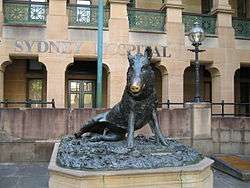Porcellino
Il Porcellino (Italian "piglet") is the local Florentine nickname for the bronze fountain of a boar. The fountain figure was sculpted and cast by Baroque master Pietro Tacca (1577–1640) shortly before 1634,[1] following a marble Italian copy of a Hellenistic marble original, at the time in the Grand Ducal collections and today in display in the classical section of the Uffizi Museum. The original, which was found in Rome and removed to Florence in the mid-16th century by the Medici, was associated from the time of its rediscovery with the Calydonian Boar of Greek myth.[2]
Tacca's bronze, which has eclipsed the Roman marble that served as model,[3] was originally intended for the Boboli Garden, then moved to the Mercato Nuovo in Florence, Italy; the fountain was placed originally facing east, in via Calimala, in front of the pharmacy that by association gained the name Farmacia del Cinghiale (Italian for "boar"). To gain more space for market traffic it was later moved to the side facing south, where it still stands as one of the most popular features for tourists. The present statue is a modern copy, cast in 1998 by Ferdinando Marinelli Artistic Foundry and replaced in 2008, while Tacca's bronze is sheltered in the new Museo Bardini in Palazzo Mozzi.
Visitors to Il Porcellino put a coin into the boar's gaping jaws, with the intent to let it fall through the underlying grating for good luck, and they rub the boar's snout to ensure a return to Florence, a tradition that the English literary traveller Tobias Smollett already noted in 1766,[4] which has kept the snout in a state of polished sheen while the rest of the boar's body has patinated to a dull brownish-green.
In popular culture
The sculpture appears in literature as well as onscreen.
In literature
The Porcellino figures in Hans Christian Andersen's "The Bronze Hog" in A Poet's Bazaar.[5]
In film
Il Porcellino appears in the 2001 film Hannibal when Chief Inspector Rinaldo Pazzi (Giancarlo Giannini) cleans his hands in the fountain.
The statue is also seen briefly in Harry Potter and the Chamber of Secrets (2002) as Harry Potter and Ron Weasley climb the Hogwarts staircase after crashing into the Whomping Willow, and again on the same staircase during the flashback scene where Tom Riddle speaks to Albus Dumbledore. It also appears in Harry Potter and the Deathly Hallows: Part II (2011) in the Room of Requirement.
Copies
Copies of the sculpture can be found around the world. Some of the locations are:
- Australia
- Sydney Hospital, Sydney, NSW[6]
- Belgium
- Enghien Park, Enghien
- Canada
- Butchart Gardens, Victoria, BC
- Modern Languages building, University of Waterloo, Waterloo, Ontario
- Denmark
- Brotorvet, Holstebro
- France
- Musée du Louvre, Paris
- Place Richelme, Aix-en-Provence
- Germany
- Sitzender Keiler (recreation by Martin Mayer) in the Borstei and in front of the Deutschen Jagd- und Fischereimuseum,[7] Munich
- Great Britain
- Derby Arboretum, Derby, England
- Chatsworth House, Derbyshire, England
- Leweston School, Dorset, England[8]
- Castle Howard, North Yorkshire[9]
- St Mary's College, Durham, Durham, England[10]
- Italy
- Japan
- Fuji City, Shizuoka Prefecture
- Norway
- Slemdal skole, Oslo
- Spain
- Parque de El Capricho, Madrid
- Sweden
- USA
- Arkansas
- University of Arkansas campus, Fayetteville
- California
- Colorado
- Delaware
- Kentucky
- Louisville, Private collector
- Louisiana
- Missouri
- Country Club Plaza, N.W. Corner of 47th Street and Wornall Road, Kansas City
- New York
- Sutton Park,[12] New York
- The Great Escape & Splashwater Kingdom amusement park at Queensbury. Just inside the entrance.
- South Carolina
- Poinsett Plaza, Greenville
- Texas
- Plaza Skillman Shopping Center, Dallas
- Dallas Zoo, Dallas
- Rice Village, Houston
- Vermont
Gallery
-

Well-worn snout of Il Porcellino in the Mercato Nuovo, Florence, Italy
-

Il Porcellino in Florence
-
Detail on the base
-
Il Porcellino, Bronzesvinet at Brotorvet, Holstebro, Denmark
-

A copy (1962) in Sydney[1]
-

In front of the Deutsches Jagd- und Fischereimuseum in Munich, Germany
References
- ↑ The commission, from Cosimo II de' Medici, dated to 1621 (Piero Torriti, Pietro Tacca da Carrara, 1975:39, noted in Haskell and Penny).
- ↑ Francis Haskell and Nicholas Penny, Taste and the Antique: the lure of classical sculpture, 1500-1900, 1981:161f.
- ↑ Haskell and Penny.
- ↑ Smollett, Travels Through France and Italy, 1766, Letter XXVIII, noted in Haskell and Penny.
- ↑ Translated by Charles Beckwith, London, 1846.
- ↑ Shirley Fitzgerald (2008). "Il Porcellino". Dictionary of Sydney. Dictionary of Sydney Trust. Retrieved 18 February 2013.
- ↑ http://www.jagd-fischerei-museum.de
- ↑ Historic England. "Statue of Boar at North-east end of path to the Italian Garden (Grade II) (1119167)". National Heritage List for England. Retrieved 23 August 2013.
- ↑ Historic England. "Statue of Wild Boar and pedestal (Grade II*) (1172729)". National Heritage List for England.
- ↑ http://www.andythornton.com/en-UK/news_articles/54-statuary-at-st-mary-s-college-durham
- ↑ "Picture Perfect Places". Viansa Winery. Retrieved 23 August 2013.
- ↑ "Il Porcellino - Manhattan, NY". 12 January 2008. Retrieved 23 August 2013.
- ↑ "Il Porcellino - Lyndon Center, Vermont". 7 August 2008. Retrieved 23 August 2013.
External links
| Wikimedia Commons has media related to Porcellino. |
- Porcellino (Museum of Outdoor Arts)
- Smithsonian Institution SIRIS Inventory
- The Florentine - article » The Porcellino
- The legend of Porcellino